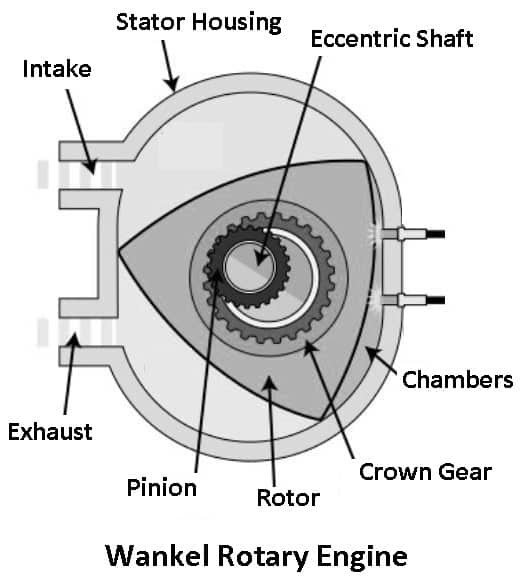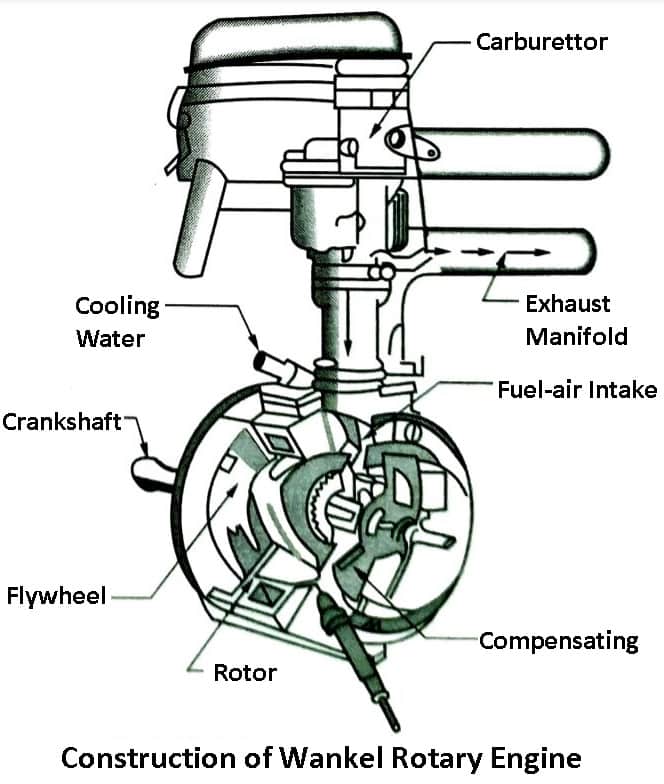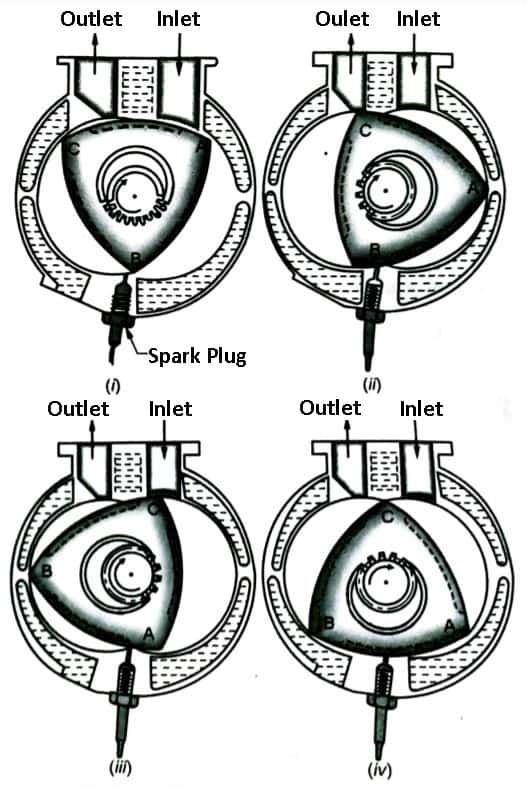Rotary Engine Construction And Operation
In this article, you will learnhow does a Wankel rotary engine works? And its parts, functions, advantages, and applications are explained with diagrams.
Furthermore, you can alsodownload the PDF file of this article at the end.
What is Wankel Rotary Engine?
It is defined as a rotary internal combustion engine in which a curved, triangular, or eccentrically pivoted piston rotates in an elliptical chamber, creating three combustion spaces that differ in volume. Or in simple words, it is a type of internal combustion engine that uses an eccentric rotary design to convert pressure into rotational motion.

The German engineer Felix Wankel invented the rotary engine known as the Wankel rotary engine and it mostly used in race cars. The Wankel engine works on the ordinary Otto cycle but differs from the reciprocating I.C. engines.
It is purely a rotary engine having no reciprocating part or piston. Compared to reciprocating piston engines, Wankel engines provide more torque, less vibration, and, for a given power, are more compact and weigh less.
It makes use of a rotor, instead of a piston, which turns inside a chamber. This design gives a new challenge to the existing reciprocating engines.
Read Also: What are the parts inside a Car? [Explained with Diagrams]
Parts of Wankel Rotary Engine
Following are the parts of a Wankel rotary engine:
- Intake
- Exhaust
- Crown gear
- Rotor
- Combustion chamber
- Housing
- Eccentric shaft
- Apex seal
- Spark plug

#1 Intake
The intake starts when the tip of the rotor passes through the intake port. At this point, the chamber is at its smallest position and expands as it spins.
#2 Exhaust
When the tip passes through this exhaust port, high-pressure exhaust gas can flow through this port.
#3 Crown Gear
In the Wankel engine, crown gear has teeth that project at right angles to the face of the wheel.
#4 Rotor
The Wankel rotary engine commonly uses a triangular-shaped rotor. This rotor is consists of three convex faces, every faces acts as a piston. The rotor works as a prime mover in the Wankel rotary engine.
The combustion is generated by burning the fuel and is applied directly to the rotor, so it spins eccentrically. On one side of the rotor, it has an internal timing gear that mashes with the fixed timing gear located on the side housing to keep the correct connection between the rotor and the eccentric shaft.
#5 Combustion Chamber
The rotor in the Wankel engine rotates with an orbital motion in a specially shaped housing and makes the crescent-shaped combustion chambers between its sides and the curved wall of the housing.
#6 Housing
It is an oval-like epitrochoid-shaped housing enclosing a triangular rotor with bow-shaped faces that resemble a Reuleaux triangle. The housing consists of an inlet, outlet port, spark plug, and water jacket, etc.
This engine has several housings, with two housings that are important, they are:
- Main Housing: It is closed using side housings.
- Side Housing: It consists of a fixed timing gear that mashes with the internal timing gear. It keeps the correct connection between the rotor and the eccentric shaft.
#7 Eccentri Shaft
It is the useful part that is used to convert the eccentric motion of the rotor into concentric motion and take it out of the engine.
The rotors ride on an eccentric (corresponding to a crankpin) integral to the eccentric shaft (corresponding to a crankshaft). The rotor rotates around the eccentrics and make an orbital rotation around the eccentric shaft.
#8 Apex Seal
The sides of the triangular rotor act as pistons, so this entire chamber needs to be sealed. In order to seal the chamber, the apex seals are used. They are made of curved metal that is placed in contact with the engine housing when the rotor is moving.
#9 Spark Plug
The Wankel engine uses two spark plugs, i.e, a leading, and a trailing spark plug. The leading plug (located at the bottom of the rotor housing) burns up to 95% of the air/fuel mixture providing much power.
Construction of a Wankel Engine

Figures show a simplified diagram of the Wankel Rotary Engine. It consists of a three-lobe rotor (a rotor of tri-angular shape with curved sides), that rotates eccentrically in an oval chamber. The rotor is mounted on the crankshaft through external and internal gears.
The rotor lobes are sealed tightly against the sides of the oval chamber. The combustion of rotor and chamber shapes ensures that they remain in contact with each other throughout the rotation. The rotor has an oval-shaped depression on its three sides between the lobes.
Read Also: How does a Turbocharger work? Advantages & Disadvantages with PDF
How Wankel Engine Works?
Typically, a Wankel rotor engine has a three-lobe rotor, which forms three spaces around it in an oval chamber. The four main cycles of intake, compression, power, and exhaust run simultaneously in three places around the rotor during the engine is operating.

The figures (i) represent the fuel intake, in which the rotor side AB creates suction. The mixture of the air/fuel from the carburetor enters the suction chamber. As the rotor turns clockwise, the mixture is compressed between the rotor and the chamber as at (ii).
Further, it is ignited, burnt gases expand turning the rotor, as at (iii), and finally, the exhaust gases are pushed out of the chamber as at (iv). The rotor side AB is again in the initial position to take the fresh charge. Thus, the cycle is complete.
The same cycle of operations goes on on all three sides of the rotor simultaneously. It is obvious that there are three power impulses in every revolution of the rotor, which is three times compared to a two-stroke engine and six times compared to a four-stroke engine.
The engine delivers power almost continuously. The eccentric motion of the rotor produces vibrations, which are reduced by using a symmetrically mounted flywheel.
Advantages of Wankel Rotary Engine Over Reciprocating Engine
- Wankel rotary engine is smaller in size, lighter in weight and more compact as compared to the reciprocating engines.
- It is cheaper and simpler in construction for mass production due to the absence of many working parts like connecting rod, crankshaft, valve mechanism, etc.
- Its balancing is easier because it does not contain any reciprocating parts. Road test have proved that this engine is practically free of vibrations.
- Wankel engine volumetric efficiency is very high, often exceeding 100%.
- Its power output per kg of engine is considerably higher.
- The Wankel engine requires a less running cost than the reciprocating engine.
- It does not require overdrive because its speed is very high.
Disadvantages of Wankel Engine
- Higher fuel consumption at low speed ranges and higher oil consumption per B.H.P.
- Lower torque speeds.
- Braking effect of the engine is far less.
- Reduction of speed in transmission is necessary due to very high engine speed.
- Due to the ignition troubles experienced with ordinary ignition system. Spark plugs need to be changed periodically. However, this has been removed by using transistorized ignition.
- The main obstacles in the development of the Wankel rotary engine was the sealing problem, which have been largely overcome by now.
- Cylinder distortion may occur due to the close proximity of inlet and exhaust ports.
- Very high exhaust gas temperatures, nearly 1600°F creates problem in exhaust manifold and silencer designs.
Applications of Wankel Rotary Engine
Following are the applications of the Wankel rotary engine:
- The Mazda 12A engine was the first engine to be built with a Wankel engine.
- It is specifically designed to produce a light, reliable, and relatively powerful engine for use in aircraft.
- Motorcycle manufacturers also prefer Wankel engines due to their small size and attractive power-to-weight ratio.
- Due to the compact size and high power-to-weight ratio of the Wankel engine, it has been suggested for electric vehicles to provide supplemental power when electric battery levels are low.
- Smaller Wankel engines are increasingly being observed in other applications, such as auxiliary power units for go-karts, and personal watercraft.
- The Wankel engine simplicity makes it suitable for mini, micro, and micro-mini engine designs.
Difference Between Rotary Engine and Reciprocating Engine
| Rotary Engine | Reciprocating Engine |
|---|---|
| A rotary engine hasfour separate sections, and each one performs a specific job: intake, compression, combustion (or ignition), or exhaust. | A reciprocating engine is one of two types of combustion engines, which work by combusting fuel to create energy. |
| A rotor rotary engine has three moving parts, that is, two rotors and an output shaft. | Simple reciprocating engines have at least 40 moving parts. |
| In rotary engines, the rotor rotates continuously in one direction. | Compared to a reciprocating engine, the pistons change direction suddenly. |
| The main moving parts in a rotary engine move at a slower speed, so it improves reliability. | In a reciprocating engine, the main moving parts move at high speed, so it reduces reliability. |
Closing It Up
As far as we discussed there are many benefits of the Wankel engine and there are also many drawbacks. These engines definitely have their place in this world. However, due to the increased maintenance to keep them running well and the costs associated with driving one.
Now, I hope you have learned about the "Wankel Rotary Engine" and found something you haven't heard before. Still, if you have any questions or doubts regarding this article, feel free to ask in the comments, I will respond to you. So, if you liked this article, then please share it with your friends.
Want Free PDFs in your inbox? Then simply subscribe to our newsletter.
Download PDF file of this article:
You might want to read more articles in our blog:
- What is the main function of a suspension system in a Car?
- How Disck Brakes are deffer from Drum Brakes? PDF
- Top 10 Easy Tips to Save Fuel while Driving.
External Links:
- wikipedia.org/wiki/
- autoevolution.com/
- energyeducation.ca/encyclopedia/
Source: https://www.theengineerspost.com/wankel-rotary-engine/
Posted by: bartoloroyaloe.blogspot.com
Posting Komentar untuk "Rotary Engine Construction And Operation"